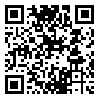Volume 7, Issue 4 (10-2022)
CJHR 2022, 7(4): 185-192 |
Back to browse issues page
Download citation:
BibTeX | RIS | EndNote | Medlars | ProCite | Reference Manager | RefWorks
Send citation to:



BibTeX | RIS | EndNote | Medlars | ProCite | Reference Manager | RefWorks
Send citation to:
Jose P, Bhaskaran R, Vijay S, Rajmohan P, Mohammed Rafi A, Uttumadathil Gopinathan U, et al . Sequential observation of antibody response pattern at 3 and 6 months following ChAdOx1 nCoV-19 vaccination among health care workers-A prospective single cohort study. CJHR 2022; 7 (4) :185-192
URL: http://cjhr.gums.ac.ir/article-1-270-en.html
URL: http://cjhr.gums.ac.ir/article-1-270-en.html
Ponnu Jose1 

 , Ramesh Bhaskaran2
, Ramesh Bhaskaran2 

 , Sreeraj Vijay2
, Sreeraj Vijay2 

 , Priyanka Rajmohan *3
, Priyanka Rajmohan *3 

 , Aboobacker Mohammed Rafi2
, Aboobacker Mohammed Rafi2 

 , Unnikrishnan Uttumadathil Gopinathan1
, Unnikrishnan Uttumadathil Gopinathan1 

 , Joe Thomas1
, Joe Thomas1 

 , Susheela J Innah2
, Susheela J Innah2 

 , Lucy Raphael1
, Lucy Raphael1 

 , Chithra Valsan4
, Chithra Valsan4 

 , Praveenlal Kuttichira5
, Praveenlal Kuttichira5 




 , Ramesh Bhaskaran2
, Ramesh Bhaskaran2 

 , Sreeraj Vijay2
, Sreeraj Vijay2 

 , Priyanka Rajmohan *3
, Priyanka Rajmohan *3 

 , Aboobacker Mohammed Rafi2
, Aboobacker Mohammed Rafi2 

 , Unnikrishnan Uttumadathil Gopinathan1
, Unnikrishnan Uttumadathil Gopinathan1 

 , Joe Thomas1
, Joe Thomas1 

 , Susheela J Innah2
, Susheela J Innah2 

 , Lucy Raphael1
, Lucy Raphael1 

 , Chithra Valsan4
, Chithra Valsan4 

 , Praveenlal Kuttichira5
, Praveenlal Kuttichira5 


1- Department of Community Medicine, Jubilee Mission Medical College, Thrissur, Kerala, India
2- Department of Transfusion Medicine, Jubilee Mission Medical College, Thrissur, Kerala, India
3- Department of Community Medicine, Jubilee Mission Medical College, Thrissur, Kerala, India ,priyankarajmohan@gmail.com
4- Department of Microbiology, Jubilee Mission Medical College, Thrissur, Thrissur, Kerala, India
5- Department of Psychiatry, Jubilee Mission Medical College, Thrissur, Kerala, India
2- Department of Transfusion Medicine, Jubilee Mission Medical College, Thrissur, Kerala, India
3- Department of Community Medicine, Jubilee Mission Medical College, Thrissur, Kerala, India ,
4- Department of Microbiology, Jubilee Mission Medical College, Thrissur, Thrissur, Kerala, India
5- Department of Psychiatry, Jubilee Mission Medical College, Thrissur, Kerala, India
Abstract: (1742 Views)
Background: The duration of the immune response induced by ChAdOx1 nCoV-19 vaccination in a real-world setting is unknown.
Objectives: This study is aimed to estimate the 6-month trend of SARS-CoV-2 antibody titer after Covishield vaccination among Health Care workers (HCW) and their associated factors.
Materials & Methods: A prospective single cohort study of health care workers was done in a tertiary care-teaching institute of central Kerala from January 2021 to October 2021. HCWs who have given pre-vaccination serum sample for SARS-CoV-2 antibody estimation and negative for SARS-CoV-2 antibody were included. They were followed up and their blood samples to check for antibody levels were taken 28 days after first dose, 2 weeks after second dose, and 3 and 6 months after first dose of ChAdOx1 nCoV-19 vaccine. Samples taken from 102 HCW were sent for SARS-CoV-2 IgG antibody testing. Quantitative results were reported as signal to cut-off (S/C) value.
Result: Mean age of the study participants was 39.3 (age range:19-71) yrs. and 71.6% were females. Antibody levels of participants at 3rd month ranged from 0.28 S/C to 21.2 S/C with a mean of 8.01. Only 34 (33.3%) HCW had IgG antibody levels >9.5 S/C. Mean antibody level further declined to 6.09 S/C at 6th month. Only 19 (28.4%) had antibody levels more than 9.5 S/C at 6th month. HCW with aged less than 50 years and those who had COVID disease during the study period had a significantly higher level of IgG antibody titres.
Conclusion: The study found that after vaccination with Covishield vaccine IgG levels peaked at 14 days following second dose of vaccine, then getting decreased in the third month and further in sixth month confirming the need for a booster dose. COVID antibody levels were significantly higher in COVID infected HCW and in young age participants.
Objectives: This study is aimed to estimate the 6-month trend of SARS-CoV-2 antibody titer after Covishield vaccination among Health Care workers (HCW) and their associated factors.
Materials & Methods: A prospective single cohort study of health care workers was done in a tertiary care-teaching institute of central Kerala from January 2021 to October 2021. HCWs who have given pre-vaccination serum sample for SARS-CoV-2 antibody estimation and negative for SARS-CoV-2 antibody were included. They were followed up and their blood samples to check for antibody levels were taken 28 days after first dose, 2 weeks after second dose, and 3 and 6 months after first dose of ChAdOx1 nCoV-19 vaccine. Samples taken from 102 HCW were sent for SARS-CoV-2 IgG antibody testing. Quantitative results were reported as signal to cut-off (S/C) value.
Result: Mean age of the study participants was 39.3 (age range:19-71) yrs. and 71.6% were females. Antibody levels of participants at 3rd month ranged from 0.28 S/C to 21.2 S/C with a mean of 8.01. Only 34 (33.3%) HCW had IgG antibody levels >9.5 S/C. Mean antibody level further declined to 6.09 S/C at 6th month. Only 19 (28.4%) had antibody levels more than 9.5 S/C at 6th month. HCW with aged less than 50 years and those who had COVID disease during the study period had a significantly higher level of IgG antibody titres.
Conclusion: The study found that after vaccination with Covishield vaccine IgG levels peaked at 14 days following second dose of vaccine, then getting decreased in the third month and further in sixth month confirming the need for a booster dose. COVID antibody levels were significantly higher in COVID infected HCW and in young age participants.
Article Type: Original Contributions |
Subject:
Public Health
Received: 2022/08/8 | Accepted: 2022/09/27 | Published: 2022/10/1
Received: 2022/08/8 | Accepted: 2022/09/27 | Published: 2022/10/1
Send email to the article author
| Rights and permissions | |
 |
This work is licensed under a Creative Commons Attribution-NonCommercial 4.0 International License. |






